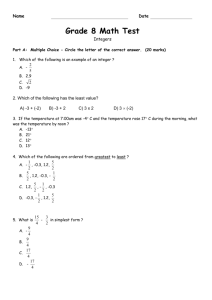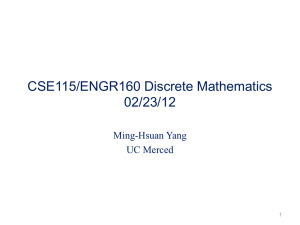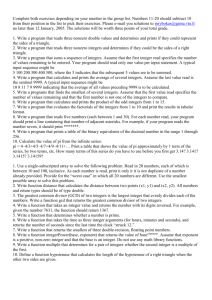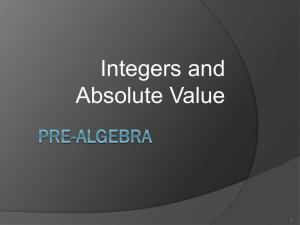se_91-92
advertisement
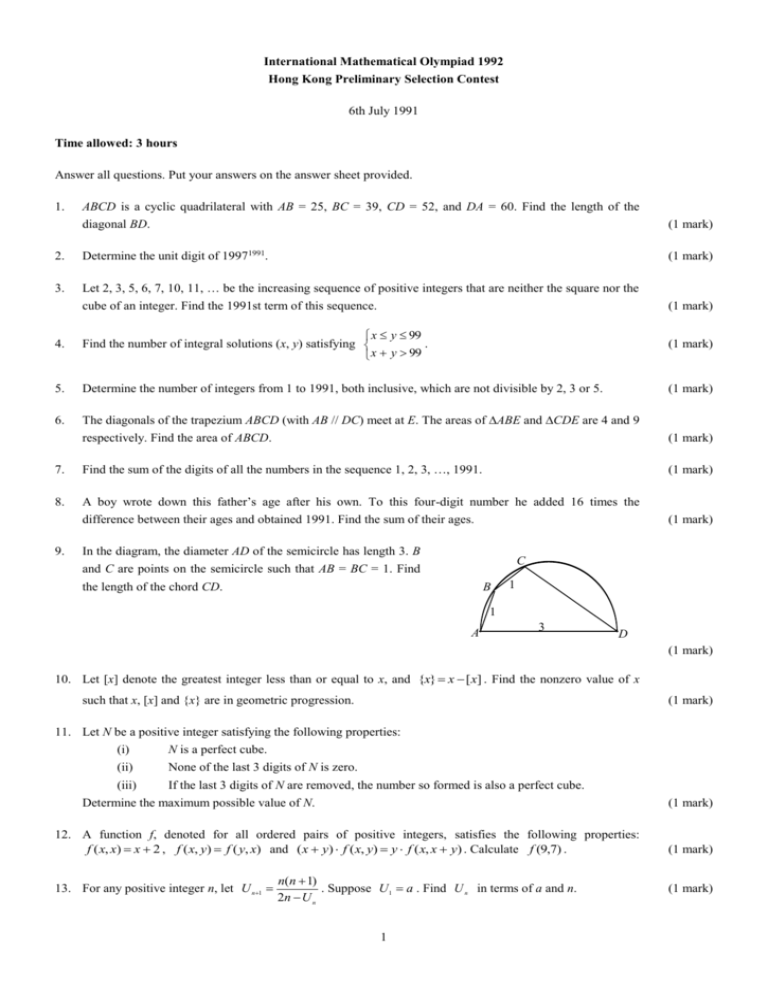
International Mathematical Olympiad 1992
Hong Kong Preliminary Selection Contest
6th July 1991
Time allowed: 3 hours
Answer all questions. Put your answers on the answer sheet provided.
1.
ABCD is a cyclic quadrilateral with AB = 25, BC = 39, CD = 52, and DA = 60. Find the length of the
diagonal BD.
(1 mark)
2.
Determine the unit digit of 19971991.
(1 mark)
3.
Let 2, 3, 5, 6, 7, 10, 11, … be the increasing sequence of positive integers that are neither the square nor the
cube of an integer. Find the 1991st term of this sequence.
(1 mark)
4.
x y 99
Find the number of integral solutions (x, y) satisfying
.
x y 99
(1 mark)
5.
Determine the number of integers from 1 to 1991, both inclusive, which are not divisible by 2, 3 or 5.
(1 mark)
6.
The diagonals of the trapezium ABCD (with AB // DC) meet at E. The areas of ABE and CDE are 4 and 9
respectively. Find the area of ABCD.
(1 mark)
7.
Find the sum of the digits of all the numbers in the sequence 1, 2, 3, …, 1991.
(1 mark)
8.
A boy wrote down this father’s age after his own. To this four-digit number he added 16 times the
difference between their ages and obtained 1991. Find the sum of their ages.
9.
(1 mark)
In the diagram, the diameter AD of the semicircle has length 3. B
C
and C are points on the semicircle such that AB = BC = 1. Find
the length of the chord CD.
B
1
1
A
3
D
(1 mark)
10. Let [x] denote the greatest integer less than or equal to x, and {x} x [ x] . Find the nonzero value of x
such that x, [x] and {x} are in geometric progression.
(1 mark)
11. Let N be a positive integer satisfying the following properties:
(i)
N is a perfect cube.
(ii)
None of the last 3 digits of N is zero.
(iii)
If the last 3 digits of N are removed, the number so formed is also a perfect cube.
Determine the maximum possible value of N.
(1 mark)
12. A function f, denoted for all ordered pairs of positive integers, satisfies the following properties:
f ( x, x) x 2 , f ( x, y) f ( y, x) and ( x y) f ( x, y) y f ( x, x y) . Calculate f (9,7) .
13. For any positive integer n, let U n1
n(n 1)
. Suppose U1 a . Find U n in terms of a and n.
2n U n
1
(1 mark)
(1 mark)
14. A flight of stairs consists of ten steps. A boy can climb one or two steps at each time. In how many ways can
the boy climb from the bottom to the top of the stairs?
(2 marks)
15. Let n be the smallest positive integer that is a multiple of 1991 and that has exactly 1991 positive integral
divisors; including 1 and itself. Express n as a product of prime factors.
(2 marks)
16. Let a, b and c be the lengths of the sides of a triangle and let p, q, r be respectively the distances from the
a2 b2 c2
centroid to the corresponding vertices. Find the ratio
.
p2 q2 r 2
(2 marks)
17. Let a be the sum of the digits of 310000, when it is written in decimal form, b be the sum of the digits of a and
c be the sum of the digits of b. Find c.
(2 marks)
18. Find the real solutions of the equation 3 x 2 [ x] 3 , where [x] denotes the greatest integer less than or
equal to x.
(2 marks)
19. What is the minimum value obtained when an arbitrary number of three different non-zero digits is divided
by the sum of its digits?
(2 marks)
20. An equilateral triangle ABP with side AB of length 3 is placed
Z
Y
inside a square AXYZ with side AX of length 6. The triangle is
rotated clockwise about B until BP falls on BX; it is then rotated
P
about P until PA falls on XY, then about A, and so on along the
sides of the square until P, A and B all return to their original
positions. Find in terms of , the length of the path traversed by
the vertex P.
A
B
X
(2 marks)
21. On a plane, there are 10 circles. Any pair of them intersect at exactly 2 points but no 3 of them intersect at
one common point. Into how many parts do these circles divide the plane?
(2 marks)
22. The integers 1, 2, …, n are arranged in such a way that if an integer k ( 1 k n ) is not the first term, then
one of the integers k 1 or k 1 appears among the terms on the left of k. How many different
arrangements are there?
(2 marks)
23. E, F, G are points on the sides AB, BC, CA respectively of ABC such that AE : EB BF : FC CG : GA
= 1 : 3. Let K, L, M be the intersection points of lines AF and CE, BG and AF, and CE and BG respectively.
area of KLM
Find the ratio
.
area of ABC
(3 marks)
24. Let [x] denote the greatest integer less than or equal to x. How many of the first 100 positive integers can be
expressed in the form [2x] + [4x] + [6x] + [8x] where x is a real number?
(3 marks)
25. A collection of k distinct integers is chosen from the integers 1, 2, …, 1991. It is required that the difference
of any two integers from the collection does not divide the sum of the corresponding integers. Determine the
maximum possible value of k.
(3 marks)
END OF PAPER
2

